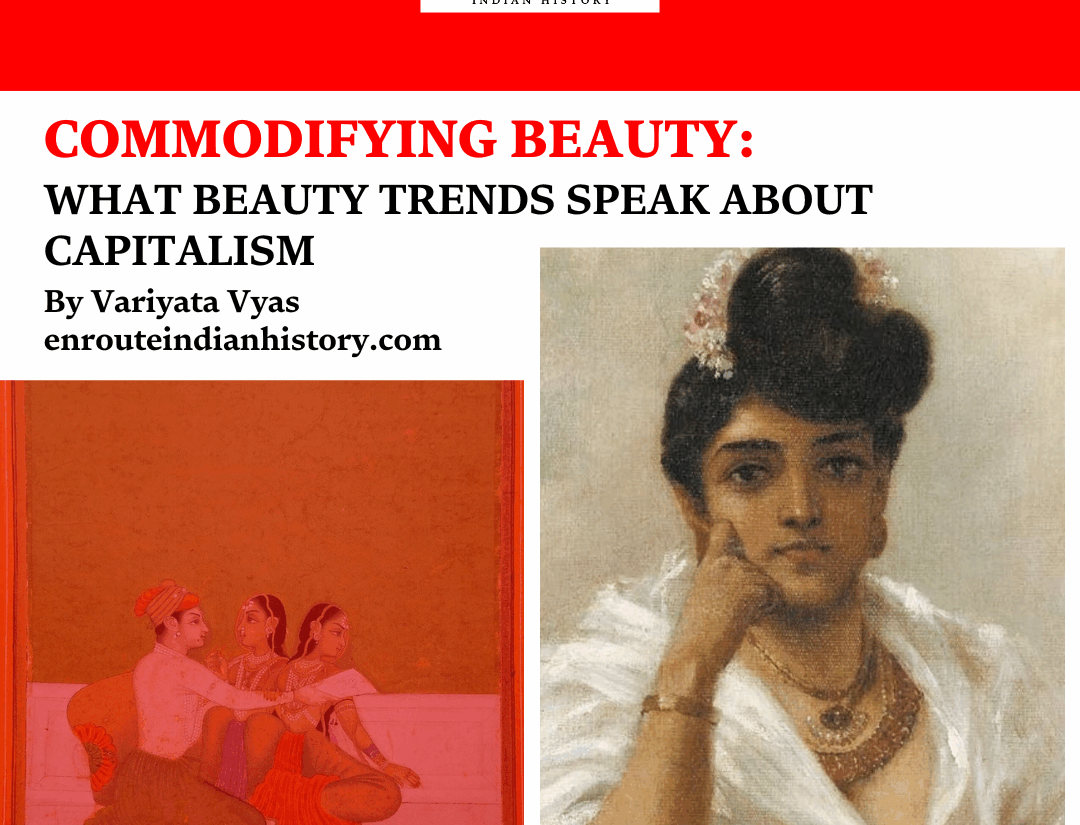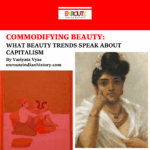Commodifying Beauty: What Beauty Trends Speak About Capitalism
- iamanoushkajain
- May 13, 2025

By Variyata Vyas
TIn his seminal work One-Dimensional Man (1964), social critic Herbert Marcuse clearly distinguishes between “false needs” and “true needs.” While true needs are rooted in autonomy, creative fulfillment, and human connection, false needs are artificially constructed or engineered by advertising, media, and corporate culture to perpetuate consumption. According to Marcuse, capitalism progresses not by addressing authentic human desires, but by creating artificial ones and then offering their simulated satisfaction. Beauty trends in the contemporary world offer a striking example of this dynamic. They circulate through social media and blogs and become tools for brands to market products, transforming personal style into a continuous consumer cycle. Beauty brands like Lakmé, Maybelline, and Fair & Lovely (now rebranded as Glow & Lovely) have long associated women’s success and empowerment with facial appearance in brand advertisements.
he way beauty products are marketed has shifted from traditional television advertisements to being more present on social media platforms. The Nykaa Beauty Summit Report 2024 points to a rising trend called “stepification,” where people, especially Gen Z and young millennials, follow detailed, multi-step skincare routines. It also reveals that social media platforms like Instagram and TikTok play a big role in promoting beauty products. At the same time, beauty knowledge has become more accessible online, leading to the quick popularity of products like sunscreen sticks and moisturizer sprays. These fast-moving trends, or microtrends, shape what people buy and how they see themselves. As brands rush to meet this demand, beauty becomes more about constant buying and selling, making personal identity something that’s increasingly tied to consumption. This creates room for new beauty trends to emerge and evolve rapidly.
Moreover, because social media feels personal and relatable, the promotion of beauty products through these platforms creates an impression of creative expression and easy access to a wide range of aesthetics, especially through influencers. However, at the same time, it blurs the line between genuine self-expression and targeted advertising. What seems like authentic sharing often serves to reinforce consumerist values, shaping identities around what can be purchased. This dynamic shows how beauty marketing on social media plays an active role in sustaining capitalism by commodifying individuality and packaging it as empowerment.
Beauty trends can be broadly divided into two categories: those that focus on appearance, like the face, hair, and skincare through beauty products and ingredients, and those that involve modifying the body itself through more intense or medical means. The first category includes makeup routines, hairstyles, and skincare trends such as the “Clean Girl” aesthetic, glass skin, no-makeup makeup, and step-by-step skincare. The second category involves beauty trends that go beyond the surface and target the body more directly, often through medical or semi-medical procedures. Examples include the growing use of Ozempic for weight loss, Botox injections, lip fillers, and cosmetic surgeries like breast augmentation and liposuction. These interventions reflect a capitalist logic, where the body itself becomes a site for investment, transformation, and control. These practices are often expensive, carry health risks, and require ongoing maintenance, locking individuals into long-term consumer dependency. They also promote a narrow and often harmful ideal of beauty as thin, youthful, and sculpted, which reinforces class inequality by making certain body types more attainable for those with greater financial means. In both cases, capitalism shapes beauty not as a personal choice, but as a never-ending project of self-improvement tied to market trends and purchasing power.
In the digital era, beauty trends spread quickly, largely influenced by influencers and celebrity culture. The “Clean Girl” aesthetic, for example, with its emphasis on glowy skin, slicked-back hair, and minimalist accessories, has been popularized by figures like Hailey Bieber and brands such as Glossier, YSL Beauty, and Rhode. While this trend promotes a polished, effortless look, it subtly glamorizes a specific kind of femininity tied to wealth and Eurocentric beauty standards. Similarly, the “no-makeup” look, which rejects the heavy-handed beauty routines of previous decades, still depends on a variety of products to achieve a curated, natural look. These trends create the illusion of simplicity and authenticity, but they depend on cycles of consumption, where beauty is polished and filtered to align with idealized, marketable forms of femininity.
The “glass skin” phenomenon, inspired by Korean skincare culture, also illustrates this cycle. It prioritizes an ultra-hydrated, luminous complexion that often requires extensive and costly routines. While the trend has its origins in a different cultural context, it has been embraced globally and absorbed into Western beauty markets, fueling product development and marketing strategies. Similarly, trends like overlined lips and lip fillers, popularized by celebrities such as Kylie Jenner, reflect a growing normalization of cosmetic procedures. Mainstream fashion media, including outlets like Vogue, play a significant role in shaping beauty culture while reinforcing the commodification of self-care. In its “Top 10 Spring Beauty Trends of 2025,” Vogue highlights trends like playful color, lived-in finishes, and skin that “looks like skin.” While this may suggest a more natural aesthetic, achieving it depends heavily on curated products, including beauty tools, high-tech ingredients, and treatments like lasers and microneedling. This shift in beauty trends doesn’t reject consumption; rather, it refines it. As Marcuse would argue, these trends satisfy “false needs”, not the need for actual well-being, but for socially conditioned ideals of radiance and flawlessness. Even when people reject exaggerated skincare claims, they often just switch to new routines that still involve buying products, so what looks like empowerment or simplicity is just another form of consumerism. Therefore, beauty trends reveal that capitalism flourishes by creating false needs, turning self-care and authenticity into endless cycles of consumption disguised as empowerment.
What looks like personal choice is often shaped by market forces. People are encouraged to feel confident and authentic, but only when they fit into certain beauty standards. These standards keep changing, which means people are constantly buying new products to keep up. So instead of helping people break free from pressure to look a certain way, beauty trends quietly keep that pressure going. This version of empowerment doesn’t challenge the system; it keeps it running by making people think they’re in control when they’re still following what the market tells them.
In 1970, Marxist philosopher Louis Althusser introduced the idea of Ideological State Apparatuses (ISAs) in his work Ideology and Ideological State Apparatuses. In this work, Althusser explains how ideology plays a key role in maintaining the power of the ruling class. In his framework, the “ruling class” refers to the capitalist class, or the bourgeoisie. According to Althusser, this class uses Ideological State Apparatuses such as schools, media, culture, art, and religious institutions to maintain its dominance by shaping the beliefs and ideologies of the population, which in turn supports the capitalist system. Unlike Repressive State Apparatuses (RSAs), such as the police or military, which exert control through force, ISAs work through everyday institutions to subtly shape how people think and behave. While these systems don’t appear to be controlling us overtly, they influence our beliefs so deeply that we often fail to recognize their impact.
The concept of Ideological State Apparatuses (ISAs) can be applied to modern phenomena like influencers, social media, and beauty standards. In today’s digital age, platforms like Instagram, TikTok, and YouTube act as ISAs, shaping societal beliefs and expectations. Influencers, who often promote certain beauty ideals, are central to this process. They help perpetuate specific standards of beauty, such as clear skin, slim bodies, and flawless appearances, which are often linked to consumerism. They don’t use force to make people buy things or follow beauty trends. Instead, by constantly posting flawless selfies, skincare routines, and product reviews, they create and reinforce ideas of what beauty should look like. For instance, the trend of “glass skin” has become widely accepted not because anyone demanded it, but because people keep seeing it online, admiring it, and trying to achieve it. Even when influencers talk about body positivity or self-love, the message is often tied to consumption: confidence is shown through the right products, routines, and aesthetics. Hence, beauty trends show that capitalism spreads its influence not through force, but by shaping desires and ideals subtly through culture, making consumption feel like a personal choice.
One of the starkest examples of how beauty trends intersect with late-stage capitalism is the global rise of Ozempic, a drug originally developed to manage Type 2 diabetes. Composed of semaglutide and marketed under different names, Ozempic was approved by the FDA in 2017 for improving insulin production and lowering blood sugar levels in diabetic patients (UC Davis Health, 2023). However, it has recently gained traction among celebrities and influencers as a rapid weight-loss solution. Its medical purpose has been sidelined in favor of its cosmetic appeal, marking a textbook case of how capitalism co-opts pharmaceutical innovation to reinforce dominant beauty ideals. In India, although not yet as widespread as in the West, anecdotal reports indicate rising interest in the drug among upper-middle-class and urban consumers [The Print, 2024]. Influencer culture and aspirational aesthetics, frequently influenced by Western ideals of slimness, are subtly fueling demand. Meanwhile, diabetic patients, particularly from low-income backgrounds, struggle with access and affordability, revealing a systemic prioritization of appearance over healthcare equity (UC Davis Health, 2023).
This change is part of a larger distortion in public health messaging and pharmaceutical priorities. Although semaglutide supports weight loss by replicating hormones that create a feeling of fullness and slow digestion, similar to the effects of bariatric surgery, its use for weight loss is still off-label (UC Davis Health, 2023). A higher-dose version, Wegovy, was FDA-approved in 2021 for chronic weight management, but Ozempic continues to be widely used due to better insurance coverage and greater availability. Health experts caution that weight loss results are often temporary, with most individuals regaining weight once the drug is stopped [UC Davis Health, 2023]. Yet, the allure of rapid transformation persists, propelled by aesthetic anxieties and the promise of thinness as a marker of success. As demand begins to rise in India, particularly in luxury wellness spaces, the drug remains largely inaccessible to most patients, with supplies limited to those who can afford to procure it through unofficial or private channels [The Print, 2024].
This phenomenon lays bare a systemic failure where beauty is monetized, healthcare is stratified, and access becomes contingent not on need, but on the ability to buy into an ideal. In countries like India, where healthcare access is already stratified by class, the entry of Ozempic into urban elite circles highlights the medical injustice of capitalist beauty culture. Those who need it to survive may struggle to find it, while those who have money can easily afford it. This dynamic isn’t just unethical, it represents how capitalism allocates resources: not by need, but by purchasing power. Ozempic’s rise parallels how beauty trends increasingly blur into medical territory, like Botox, fillers, or prescription skincare. But this trend has reached new terrain: metabolic intervention. Weight loss is framed as a medical issue, not for health but for conformity to cultural ideals, largely Western, patriarchal, and fatphobic. Moreover, Ozempic isn’t a permanent solution. Research shows that once users stop, they often regain the weight. This ensures continued demand, much like beauty products that promise transformation but require endless repurchasing[UC Davis Health, 2023]. Hence, the Ozempic trend pushes the idea that your body is always a project to improve, as long as you have the money and motivation. This cycle mirrors the capitalist logic of perpetual consumption: offer a quick fix, avoid structural change, and ensure the consumer keeps coming back. Real, sustainable health interventions like affordable nutrition, mental health support, or systemic changes to food access aren’t as profitable.
In India, the evolution of body image ideals has been heavily influenced by both global trends and the country’s cultural history. Traditionally, Indian beauty standards celebrated fuller, curvier bodies, particularly in the context of femininity. This ideal was perpetuated by Indian cinema, especially Bollywood, where actresses with fuller figures like Hema Malini, Sharmila Tagore, Sridevi, and Madhuri Dixit were considered the epitome of beauty in the 1980s and 1990s.
However, with the rise of globalization and the influx of Western media, beauty standards began to shift dramatically. The concept of the “Size 0” body, popularized by international fashion runways and Hollywood celebrities, began to make its way into Indian fashion and media in the 2000s. Kareena Kapoor, who famously showcased her Size 0 figure in the 2008 film Tashan, became an iconic symbol of this new beauty standard (V Menon, 2023).
At the same time, the idealization of a “busty” body, characterized by large breasts and an hourglass figure, also emerged as a dominant trend in Indian beauty standards, especially within the context of sensuality. Celebrities like Kim Kardashian, Kylie Jenner, and more recently, the rise of influencers on platforms like Instagram, have popularized this curvier, bustier image. This dual demand for both extreme slimness and voluptuous curves has led to the rise of a paradoxical body ideal where women are expected to embody the perfect balance of a flat stomach and a busty figure, often requiring cosmetic procedures like breast augmentation, liposuction, and other body-shaping treatments. This contradictory beauty standard places immense pressure on women to conform to an unrealistic body type, reflecting the broader commercialization of beauty in India. The beauty industry, which profits from promoting such ideals, has contributed to reinforcing these standards, often ignoring the diverse, healthy body types that exist in reality. This shows that capitalism in beauty trends creates impossible body ideals, combining contradictory demands like thinness and curves, to fuel constant insecurity, drive cosmetic consumption, and turn women’s bodies into sites of profit.
Beauty trends on social media can offer space for self-expression, creativity, and confidence, but it’s important to remember that not all trends are equally positive. Some encourage healthier ideas of beauty, such as accepting natural features, celebrating diverse skin tones, and promoting body positivity. These shifts challenge narrow, traditional beauty standards and support a more inclusive and authentic view of beauty, where people feel free to express themselves without pressure to change. However, other trends can have the opposite effect. The obsession with “glass skin” or achieving the perfect body often promotes unrealistic and unhealthy ideals. That’s why it’s important to look at beauty trends with a critical eye. Ultimately, beauty trends are often driven by capitalism, which creates insecurities to sell products, so it’s important to question these standards and embrace a more real and inclusive idea of beauty.
References
Althusser, L., 1970. Ideology and Ideological State Apparatuses. In: Lenin and Philosophy and Other Essays. London: New Left Books, pp. 127-186.
Baruah, A., 2023. Desperate Indians want Ozempic on prescription. Huge shift from traditional drugs, say doctors. The Print, 15 October. https://www.theprint.in
Kaul, I., 2023. The seeds of body dysmorphia were planted when Bollywood embraced the size zero figure and it’s alarming. Elle, 12 September. https://elle.in/bollywoods-zero-figure-2000s/
Marcuse, H., 1964. One-Dimensional Man. Boston: Beacon Press.
Nykaa Beauty Summit, 2024. The Nykaa Beauty Summit Report 2024. https://www.google.com/search?q=The+Nykaa+Beauty+Summit+Report+2024&oq=The+Nykaa+Beauty+Summit+Report+2024&gs_lcrp=EgZjaHJvbWUyBggAEEUYOTIICAEQABgWGB4yBwgCEAAY7wUyBwgDEAAY7wUyBwgEEAAY7wUyBwgFEAAY7wUyCggGEAAYgAQYogTSAQczMDFqMGo3qAIAsAIA&sourceid=chrome&ie=UTF-8
UC Davis Health, 2023. Ozempic for weight loss: Does it work, and what do experts recommend? UC Davis Health, 19 July. https://health.ucdavis.edu/blog/cultivating-health/ozempic-for-weight-loss-does-it-work-and-what-do-experts-recommend/2023/07

















